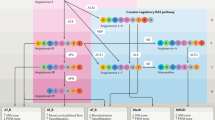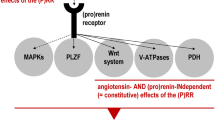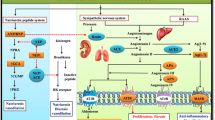Abstract
Direct renin inhibition is a new means for blocking the renin–angiotensin system at the rate-limiting step of the cascade of events triggered by renin release—the interaction of renin with its physiological substrate angiotensinogen. The remarkable success of angiotensin-converting-enzyme inhibitors and angiotensin receptor blockers in the management of cardiovascular and renal disease has led to great interest in the potential of direct renin inhibitors. This Review focuses on the evidence that suggests that direct renin inhibitors might block the renin–angiotensin system in the kidney more completely than either angiotensin-converting-enzyme inhibitors or angiotensin receptor blockers. The therapeutic implications of this evidence are also reviewed, as well as the possible mechanistic routes by which direct renin inhibition might exert its influence on the kidney.
Key Points
-
Direct renin inhibitors (DRIs) competitively bind to renin to prevent interaction between renin and angiotensinogen
-
Renin-catalyzed conversion of angiotensinogen to angiotensin I is the rate-limiting step in the event cascade that activates the renin–angiotensin system (RAS)
-
The DRI aliskiren is safe and as effective in reducing blood pressure as agents such as angiotensin-converting-enzyme inhibitors or angiotensin receptor blockers
-
Preliminary evidence indicates that DRIs improve renovascular function to a greater extent than other RAS blockade agents
-
Although prorenin is an ostensibly inactive precursor of renin, growing evidence suggests that this protein might be involved in precipitating pathological processes in patients with diabetic nephropathy
-
The potential renoprotective effects of DRIs might be explained by their targeting of renin, the effect they might have on prorenin and by the lack of treatment-associated increase in plasma renin activity
This is a preview of subscription content, access via your institution
Access options
Subscribe to this journal
Receive 12 print issues and online access
$209.00 per year
only $17.42 per issue
Buy this article
- Purchase on Springer Link
- Instant access to full article PDF
Prices may be subject to local taxes which are calculated during checkout




Similar content being viewed by others
References
Navar, L., Harrison-Bernard, L. M., Imig, J. D. & Mitchell, K. D. in Angiotensin II Receptor Antagonists 190 (eds Epstein, M. & Brunner, H. R.) 89–214 (Hanley & Belfus, Philadelphia, 2001).
Musini, V. M., Fortin, P. M., Bassett, K. & Wright, J. M. Blood pressure lowering efficacy of renin inhibitors for primary hypertension: a Cochrane systematic review. J. Hum. Hypertens. 23, 495–502 (2009).
Stanton, A., Jensen, C., Nussberger, J. & O'Brien, E. Blood pressure lowering in essential hypertension with an oral renin inhibitor, aliskiren. Hypertension 42, 1137–1143 (2003).
Pool, J. L. et al. Aliskiren, an orally effective renin inhibitor, provides antihypertensive efficacy alone and in combination with valsartan. Am. J. Hypertens. 20, 11–20 (2007).
Villamil, A. et al. Renin inhibition with aliskiren provides additive antihypertensive efficacy when used in combination with hydrochlorothiazide. J. Hypertens. 25, 217–226 (2007).
Oparil, S. et al. Efficacy and safety of combined use of aliskiren and valsartan in patients with hypertension: a randomized, double-blind trial. Lancet 370, 221–229 (2007).
Hollenberg, N. K. Renin inhibition: what are the clinical perspectives? Semin. Nephrol. 27, 511–518 (2007).
Krop, M. et al. Aliskiren accumulates in renin secretory granules and binds plasma prorenin. Hypertension 52, 1076–1083 (2008).
Muller, D. N. & Luft, F. C. Renin receptor blockade: a better strategy for renal protection than renin-angiotensin system inhibition? Curr. Hypertens. Rep. 10, 405–409 (2008).
Schefe, J. H. et al. Prorenin engages the (pro)renin receptor like renin and both ligand activities are unopposed by aliskiren. J. Hypertens. 26, 1787–1794 (2008).
Skeggs, L. T. Jr, Kahn, J. R., Lentz, K. & Shumway, N. P. The preparation, purification, and amino acid sequence of a polypeptide renin substrate. J. Exp. Med. 106, 439–453 (1957).
Hollenberg, N. K. Implications of species difference for clinical investigation: studies on the renin-angiotensin system. Hypertension 35, 150–154 (2000).
Allan, D. R., Hui, K. Y., Coletti, C. & Hollenberg, N. K. Renin vs. angiotensin-converting enzyme inhibition in the rat: consequences for plasma and renal tissue angiotensin. J. Pharmacol. Exp. Ther. 283, 661–665 (1997).
Neisius, D., Wood, J. M. & Hofbauer, K. G. Renal vasodilatation after inhibition of renin or converting enzyme in marmoset. Am. J. Physiol. 251, H897–H902 (1986).
El Amrani, A. I., Menard, J., Gonzales, M. F. & Michel, J. P. Effects of blocking the angiotensin II receptor, converting enzyme, and renin activity on the renal hemodynamics of normotensive guinea pigs. J. Cardiovasc. Pharmacol. 22, 231–239 (1993).
Verburg, K. M., Kleinert, H. D., Chekal, M. A., Kadam, J. R. & Young, G. A. Renal hemodynamic and excretory responses to renin inhibition induced by A-64662. J. Pharmacol. Exp. Ther. 252, 449–455 (1990).
Huang, Y. et al. Renin increases mesangial cell transforming growth factor-beta1 and matrix proteins through receptor-mediated, angiotensin II-independent mechanisms. Kidney Int. 69, 105–113 (2006).
Feldt, S., Maschke, U., Dechend, R., Luft, F. C. & Muller, D. N. The putative (pro)renin receptor blocker HRP fails to prevent (pro)renin signaling. J. Am. Soc. Nephrol. 19, 743–748 (2008).
Cordero, P. et al. Renal and endocrine responses to a renin inhibitor, enalkiren, in normal humans. Hypertension 17, 510–516 (1991).
Hollenberg, N. K. & Fisher, N. D. Renal circulation and blockade of the renin-angiotensin system. Is Angiotensin-converting enzyme inhibition the last word? Hypertension 26, 602–609 (1995).
Fisher, N. D., Jan Danser, A. H., Nussberger, J., Dole, W. P. & Hollenberg, N. K. Renal and hormonal responses to direct renin inhibition with aliskiren in healthy humans. Circulation 117, 3199–3205 (2008).
Parving, H. H., Persson, F., Lewis, J. B., Lewis, E. J. & Hollenberg, N. K. Aliskiren combined with losartan in type 2 diabetes and nephropathy. N. Engl. J. Med. 358, 2433–2446 (2008).
Parving, H. H. et al. Aliskiren Trial in Type 2 Diabetes Using Cardio-Renal Endpoints (ALTITUDE): rationale and study design. Nephrol. Dial. Transplant. 24, 1663–1671 (2009).
Luetscher, J. A., Kraemer, F. B., Wilson, D. M., Schwartz, H. C. & Bryer-Ash, M. Increased plasma inactive renin in diabetes mellitus. A marker of microvascular complications. N. Engl. J. Med. 312, 1412–1417 (1985).
Luetscher, J. A. & Kraemer, F. B. Microalbuminuria and increased plasma prorenin. Prevalence in diabetics followed up for four years. Arch. Intern. Med. 148, 937–941 (1988).
Luetscher, J. A., Kraemer, F. B. & Wilson, D. M. Prorenin and vascular complications of diabetes. Am. J. Hypertens. 2, 382–386 (1989).
Wilson, D. M. & Luetscher, J. A. Plasma prorenin activity and complications in children with insulin-dependent diabetes mellitus. N. Engl. J. Med. 323, 1101–1106 (1990).
Nguyen, G. The (pro)renin receptor: a new kid in town. Semin. Nephrol. 27, 519–523 (2007).
Ichihara, A. et al. Inhibition of diabetic nephropathy by a decoy peptide corresponding to the “handle” region for nonproteolytic activation of prorenin. J. Clin. Invest. 114, 1128–1135 (2004).
Suzuki, F. et al. Human prorenin has “gate and handle” regions for its non-proteolytic activation. J. Biol. Chem. 278, 22217–22222 (2003).
Ingelfinger, J. R. & Dzau, V. J. Molecular biology of renal injury: Emphasis on the role of the renin-angiotensin system. J. Am. Soc. Nephrol. 2 (Suppl. 1), 9–20 (1991).
Price, D. A. et al. The paradox of the low-renin state in diabetic nephropathy. J. Am. Soc. Nephrol. 10, 2382–2391 (1999).
Author information
Authors and Affiliations
Ethics declarations
Competing interests
The author declares an association with Novartis as a recipient of grant/research support.
Rights and permissions
About this article
Cite this article
Hollenberg, N. Direct renin inhibition and the kidney. Nat Rev Nephrol 6, 49–55 (2010). https://doi.org/10.1038/nrneph.2009.201
Published:
Issue Date:
DOI: https://doi.org/10.1038/nrneph.2009.201
This article is cited by
-
Combination Use of Angiotensin Converting Enzyme Inhibitors and Angiotensin Receptor Blockers in Diabetic Kidney Disease
Current Diabetes Reports (2013)
-
Renin Inhibitors and Cardiovascular and Renal Protection: An Endless Quest?
Cardiovascular Drugs and Therapy (2013)
-
Aliskiren reduced renal fibrosis in mice with chronic ischemic kidney injury—beyond the direct renin inhibition
Hypertension Research (2012)
-
Angiotensin-converting enzyme 2: enhancing the degradation of angiotensin II as a potential therapy for diabetic nephropathy
Kidney International (2012)
-
Chronic blockade of the (pro)renin receptor ameliorates the kidney damage in the non-clipped kidney of Goldblatt hypertension
Hypertension Research (2011)



